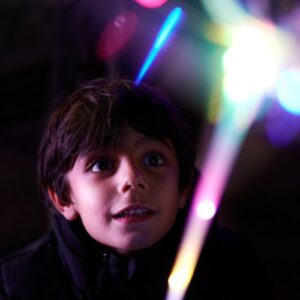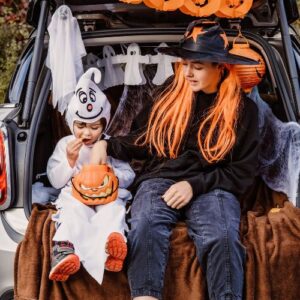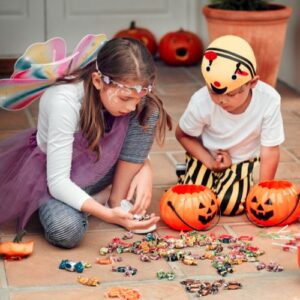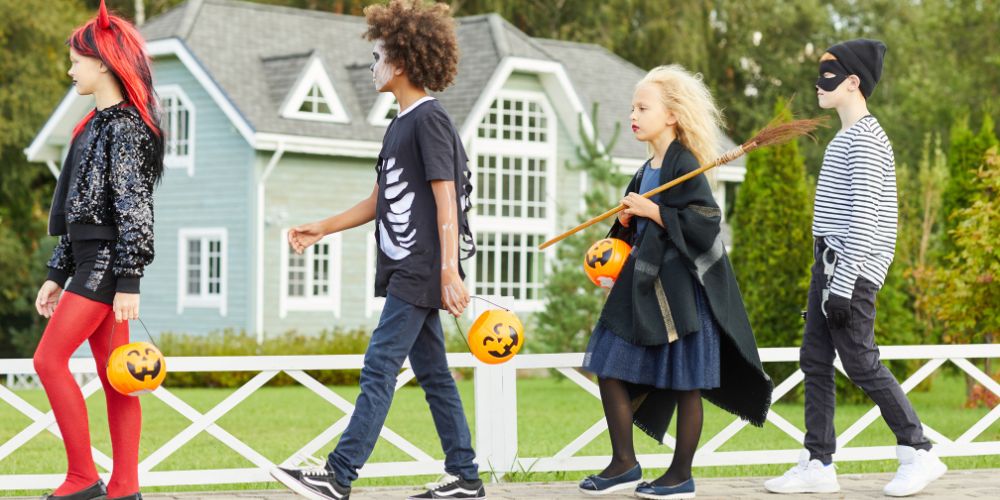Halloween Safety Tips for Trick-or-Treating
Halloween is a fun holiday that brings excitement, costumes, and candy. But for parents (especially foster parents), it’s also a time to focus on creating an experience that is both safe and enjoyable. These Halloween safety tips while trick-or-treating ensure everyone celebrates with confidence. Many foster children may be experiencing Halloween for the first time, so helping them enjoy the day safely can make it both a memorable and comforting experience.
By following a few thoughtful safety tips, parents can create a fun, secure celebration that lets every child enjoy the night.
Preparing for Trick-or-Treating
Before heading out on Halloween night, parents should plan ahead.

When helping your kids choose costumes, select ones made from flame resistant fabrics (since many people use candles in their jack o’ lanterns!) and avoid items that restrict movement or vision. Masks can make it hard to see, so use face paint instead to keep your child’s vision clear. Adding reflective tape, blinking lights, or a glow-in-the-dark touch to costumes or trick or treat bags, or have kids carry glow sticks or flashlights to light their way as they walk can help drivers spot them more clearly in the dark. These small precautions make a big difference in keeping everyone safe.
Accompany young children as they go door-to-door, and consider trick-or-treating before dark to reduce risks. For older kids, plan a route together or set a check-in time or meeting place if you feel comfortable sending them off on their own.
For foster parents, communication and reassurance are key. Many children in foster care may feel nervous in new settings or around strangers. Explain each activity ahead of time and let them know they can speak up if they feel unsafe. The goal is to ensure they have fun while feeling protected and supported.
Trick-or-Treat Home Safety
Creating a safe, well-lit space adds to the Halloween fun while protecting both visitors and your family. If you’re planning to welcome trick-or-treaters, turn on your porch light and clear your yard and walkway to prevent trips. Make sure things like rocks, decor, and cords are out of the way, or clearly visible in well-lit areas. Light jack-o’-lanterns with battery-operated candles or glow sticks instead of real flames and avoid keeping open flames near visiting trick-or-treaters.
Trunk-or-Treat and Safer Alternatives

For foster families, trunk-or-treats can be a great introduction to the holiday, as they are less overwhelming and more structured than going house to house. Parents can also stay nearby while children enjoy the fun.
Other great alternatives include:
- At-home Halloween parties with crafts, classic Halloween movies, and games like pumpkin bowling or Halloween bingo.
- A costume parade through your living room or backyard with friends and family.
- Virtual Halloween activities for families spread out in different locations—like a virtual Halloween scavenger hunt or costume contest over video chat. (This is especially useful for siblings separated in different foster homes!)
- Pumpkin carving and pumpkin painting.
- Baking pumpkin, ghost, and bat-shaped cookies, homemade green marshmallow rice krispies, and other Halloween-themed treats together.
These options help children feel safe while still experiencing the magic and excitement of Halloween in a controlled, comfortable environment.
READ MORE: 5 Family-Friendly Movies Starring Kids in Foster Care to Watch This Friday the 13th
Car Safety
Parents and drivers play a major role in Halloween safety, too. On Halloween night, drive slowly and stay alert in residential neighborhoods. Watch carefully for trick or treaters who may cross unexpectedly.
Teach children to never accept rides from strangers and to stay close to adults. Remind kids not to enter a stranger’s home, even if invited in for treats. When the night is over, carefully inspect all trick or treat bags. Throw away any homemade or unwrapped treats and avoid hard candies or small toys that could pose choking hazards. Checking together helps build trust and ensures everyone gets home safely.
Trick-or-Treat Safety for Older Kids
As kids grow older, they may want to explore more independently. For older kids, agree on safety rules in advance. Encourage them to walk, not run, stay in well-lit areas, and stick to familiar streets. Make sure they carry a phone, and set a time to check in or come home. You may even want to consider activating their phone’s Find My Phone or other GPS features so you always know where they’re at in case of an emergency.
Consider encouraging using reflective tape and other visibility aids even for older children. If they wear dark clothing, choose light colors or add glow accessories to help drivers see them. And always reinforce the importance of crossing streets safely and paying attention to their surroundings. It’s easy to get caught up in the excitement!
Candy Safety
The fear of drug-spiked candy and razor blades in apples may be a myth, but that doesn’t mean there aren’t other candy safety efforts to follow!

If one child is allergic to an ingredient, while another is not, be sure to separate their candy accordingly, or remove the allergen candy altogether to prevent a medical emergency. Never leave bags of candy unattended where children can easily access allergen-containing candies. If you know your child’s allergies, keep an epipen handy on Halloween night and for the candy-eating days after in case of anaphylaxis.
If you plan on handing out candy, choose individually wrapped treats and keep small toys or hard candies out of reach for younger children. Choose alternatives to candies that kids will still enjoy like pencils, toys, stickers, or keychains, or allergen-free treats like bubblegum or lollipops.
Final Halloween Safety Reminders
Halloween is one of the most exciting nights of the year for kids, but planning and supervision are essential for a safe Halloween. Parents should stay alert, plan ahead, and prioritize visibility. Drivers should drive slowly, watch for children who may dart into the street, and give families extra time to cross.

By focusing on Halloween safety, parents can ensure the holiday is full of laughter, light, and sweet moments—especially for children discovering the joy of Halloween for the first time.



